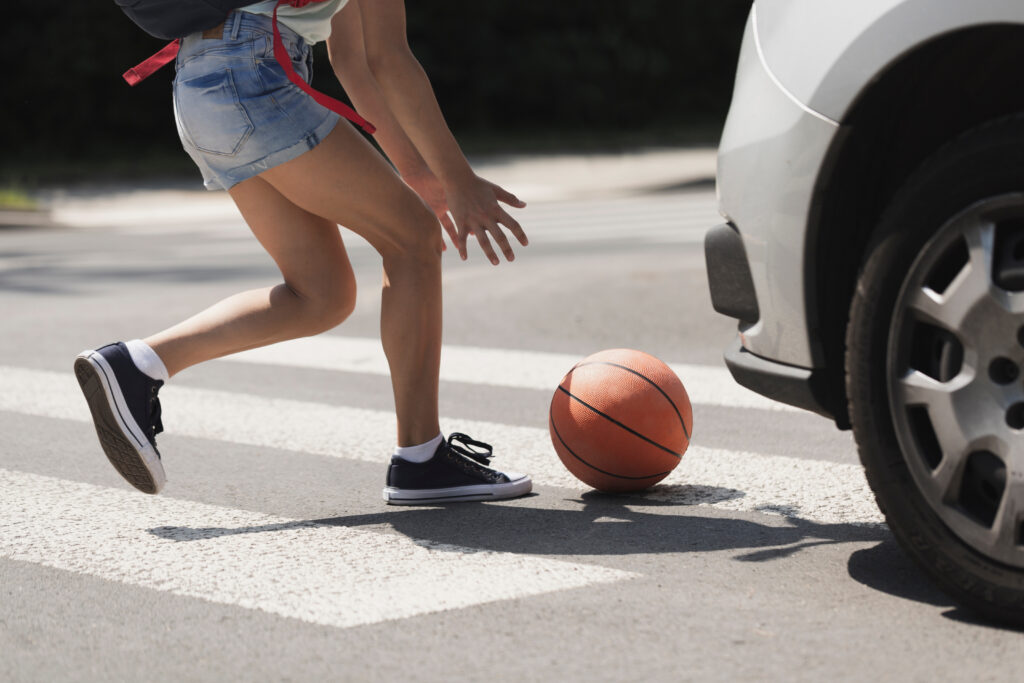Unfortunately, embracing the healthy and eco-conscious choice of walking comes with increasing risks. Each year, more Americans face the harrowing reality of losing their lives or enduring grave injuries as pedestrians. Such incidents can lead to life-altering consequences, both physically and financially.
In cases where drivers' negligence leads to pedestrian accidents, they can face consequences for their actions. A skilled pedestrian accident lawyer in Atlantic City can guide you in this endeavor. You may recover financial compensation for your injuries.
Get A Free Consultation Today!
Common Causes of Pedestrian Accidents

According to the Centers for Disease Control and Prevention (CDC), about 8,000 pedestrian fatalities in traffic accidents across the United States in one recent year averaged out to about one fatality every 66 minutes. Around 137,000 more pedestrians sustained injuries in accidents during the same year.
Here are some of the primary factors contributing to pedestrian accidents:
Distracted Driving
In today's age, abundant distractions while driving range from cell phones and apps to advanced audio systems, passengers, children, and pets. When drivers succumb to these distractions, they divert their attention from the road, significantly elevating the risk of an accident. By the time they spot a pedestrian, they cannot prevent a collision.
Impatient Driving
In most situations, pedestrians have the right of way. Even if a pedestrian doesn't notice an approaching vehicle and begins to cross against the light, they still maintain the right of way.
Drivers who fail to remain vigilant for pedestrians or attempt to maneuver around pedestrians in crosswalks can cause avoidable accidents, injuries, and fatalities.
Recklessness
Reckless driving contributes to numerous pedestrian accidents in the U.S. each year. Pedestrian safety relies on drivers who exercise caution and take proactive measures to prevent accidents. When drivers prioritize reaching their destination without regard for safety, the likelihood of innocent victims increases.
Neglecting the Right of Way
The right of way pertains to the legal entitlement of a pedestrian or driver to proceed with priority in a specific location or scenario. For example, suppose a traffic signal instructs a pedestrian to cross a crosswalk. In that case, a driver must yield to allow the pedestrian to cross before proceeding.
Failing to yield right of way occurs when the pedestrian or the driver violates traffic rules by advancing without giving precedence to the other party. For instance, if a car does not yield to a pedestrian in a crosswalk.
Poor Visibility
Various factors can diminish visibility on the road, increasing the likelihood of accidents involving pedestrians. These factors encompass adverse weather conditions, objects or vehicles on the side of the road, inadequate vehicle headlights, and bright lights causing glare.
In cases of poor visibility, liability may extend to motorists or even other parties, such as the city or road crew. However, both pedestrians and drivers should exercise extra caution in such circumstances to mitigate the risk of accidents.
Influence of Drugs, Alcohol, or Medication
Impaired judgment due to drugs, alcohol, or certain medications can significantly heighten the risk of accidents involving pedestrians. In fact, driving under the influence contributes to a substantial number of car-related accidents each year.
Drivers under the influence of alcohol, drugs, or prescription medications pose a severe risk to everyone on the road, particularly pedestrians. Impaired drivers may disregard crosswalks, occupied or not, and turn left into groups of pedestrians, resulting in severe accidents.
Sudden Running or Darting into the Road
Children and adolescents may unexpectedly dart into the road without considering oncoming traffic, leading to accidents in various areas. When a pedestrian darts into the road, a driver may lack time to respond appropriately, potentially resulting in a collision and causing significant injuries. Drivers should always prepare for the unexpected and to act quickly to a pedestrian that suddenly appears in front of them.
Multi-Lane/Arterial Roads
Arterial roads demand heightened awareness due to frequent lane changes, speeding, and hazardous driving behaviors. Drivers on these roads may not naturally look for pedestrians or notice traffic signals.
Faulty Motor Vehicles
Occasionally, pedestrian accidents result from defective motor vehicle components, such as faulty tires, leading to blowouts or brake malfunctions. In such cases, injured parties may hold the vehicle or parts manufacturer liable with the assistance of a skilled pedestrian accident attorney.
Road Construction
While road construction is typically an inconvenience, it can also introduce safety hazards. Many drivers may not anticipate pedestrians in these zones, making it crucial for motorists to remain highly attentive in construction areas.
Types of Pedestrian Incidents
Various scenarios can lead to pedestrian accidents, but certain types are particularly prevalent. A pedestrian accident occurs whenever a person on foot is in a collision with a car, truck, or motorcycle.
This can happen to pedestrians in a range of situations, including:
- Crosswalk incidents: These occur when a vehicle strikes a pedestrian who rightfully uses a crosswalk.
- Back-over/parking lot accidents: These accidents occur when a vehicle backs up, such as while entering or leaving a parking space, and collides with a pedestrian. Such incidents are common in parking lots where cars may obstruct a driver's view to either side, and pedestrians frequently cross paths with parked vehicles.
- Loss of control accidents: Includes situations where a driver strikes a pedestrian or sideswipes them on a sidewalk. These accidents often trap the pedestrian under the vehicle or between the vehicle and another stationary object, such as another vehicle, sign, post, or building. Unfortunately, these collisions pose a significant danger to a pedestrian's well-being and life.
- Hit-and-run incidents: In many cases, pedestrian accidents escalate into hit-and-run incidents, especially when the pedestrian sustains severe injuries and traffic conditions are light. Drivers involved in these situations may panic, realizing that even a minor impact from their vehicle can lead to serious pedestrian injuries. Under most state laws, a driver must remain at the accident scene if they caused personal injuries to a pedestrian. Fleeing the scene in such circumstances constitutes a hit-and-run, which many states make a felony.
When Do Pedestrians Have the Right of Way?
Pedestrians have the right of way in many situations under state laws. Even when they don't, drivers should still drive defensively and avoid accidents.
Crosswalks
Pedestrians always have the right of way in crosswalks. Under most state laws, drivers must come to a complete stop, not just yield, when a pedestrian is in a crosswalk in front of them. Drivers must also stop if a pedestrian approaches and is within one lane of the half of the street on which the vehicle is traveling or turning onto. "Half of the roadway" refers to all traffic lanes carrying traffic in the same direction of travel.
Suppose you are driving on a five-lane road (two going in both directions and a turn lane in between), and a pedestrian enters from the far side of the road, walking across the path you are traveling down. You must completely stop as soon as they walk across the turn lane onto your half of the road.
Sidewalks Perpendicular to Driveways, Parking Garages, or Alleys
Drivers emerging from driveways, parking garages, and alleys usually must stop right before driving onto a sidewalk that reaches across the exit of the alley, driveway, or parking garage. In these circumstances, the driver must yield to pedestrians present on the sidewalk but isn't required to make a complete stop.
Do You Have a Valid Pedestrian Injury Accident Claim?
You might have a valid injury claim if you or your pedestrian accident attorney can prove:
- Duty: The driver who hit you owed you a duty of care
- Breach of duty: The driver breached the duty they owed you
- Cause in fact: The driver's actions caused your injury, also known as but-for causation, meaning if it weren't for the driver's actions, you wouldn't have suffered an injury
- Proximate cause: Your injuries directly resulted from the accident
- Damages: You have compensable damages
If you think you have a valid claim, contact a qualified pedestrian accident attorney as soon as possible. Waiting too long can cause you to miss the filing deadline, evidence to disappear or degrade, and bills to stack up.
What Are Compensable Damages in a Pedestrian Accident Case?
In any personal injury claim, including pedestrian accidents, the injured party seeks to recover money for their damages.
Depending on the injuries they suffered and what their life was like before the accident, the following damages might apply in their case:
- Past and future medical bills for physician office visits, surgery, hospital stays, physical therapy, rehabilitation, and others
- Past and future lost income, including any PTO that you did not earn
- Out-of-pocket medical expenses such as medical equipment, over-the-counter and prescription medications, travel costs if you had to travel to receive necessary medical care
- Pain and suffering
- Loss of consortium/companionship
- Loss of enjoyment of life
- Scarring and disfigurement
- Worsening of prior injuries
Your pedestrian accident lawyer will accounted for all of your damages when negotiating your settlement.
How Much Is My Pedestrian Accident Case Worth?
The value of your pedestrian accident claim depends on many factors. There is no blanket answer as each case is so different. When you hire a pedestrian accident lawyer, they can provide you with an estimate of your case's value. We base this estimate on past experience, recent local similar claims, and your specific damages.
Factors that can influence the value of your case include:
- The severity of your injuries and damages
- The extent to which your injuries have disrupted your life
- The type of medical care you need
- Credible eyewitnesses
- Video surveillance footage
- The limits of the applicable insurance policies
- How many liable parties there are
- Emotional and mental trauma
- Certainty of liability
How Will You Pay Your Medical Bills if an Uninsured Driver Hit You?
Unfortunately, many drivers don't obey their state's insurance laws and carry the minimum amount of liability coverage. If the motorist who hit you doesn't have insurance coverage, you cannot seek compensation this way. However, you do have the right to file a civil lawsuit against the uninsured driver.
Sometimes, drivers fail to obtain insurance coverage because they can't afford it and might not have property or assets to sue for. Pedestrian accident victims with health insurance can use their benefits, although they still might have deductibles and copays that apply.
Suppose you happen to have uninsured motorist coverage on your own auto insurance policy. In that case, this can help pay your medical bills and lost income if an uninsured or hit-and-run driver struck you.
In either situation, getting the compensation you deserve for your damages starts with a case review from an experienced pedestrian accident attorney.
Why Having an Experienced Pedestrian Accident Attorney Matters
After a pedestrian accident, hire a dedicated advocate. You need someone who not only comprehends the steps ahead but also possesses the skills and knowledge to negotiate with the insurance company, ensuring you receive the rightful compensation you deserve. You require a legal professional who will thoroughly understand the specifics of your case and tirelessly fight for the damages owed to you.
Without legal representation, the insurance company may devalue or completely deny your injury claim by:
- Attempting to shift blame onto you for the accident in various ways
- Trying to convince you to accept a substantially lower settlement than your rightful claim value
- Contesting the severity of your injuries or disabilities or the level of medical care you need
- Dragging out the claims process unnecessarily
- Rejecting your claim outright
- Trying to coax statements from you that can be used against your interests or manipulated in their favor
Maximizing your pedestrian accident injury claim begins with contacting a knowledgeable car accident attorney as soon as possible after your accident.
